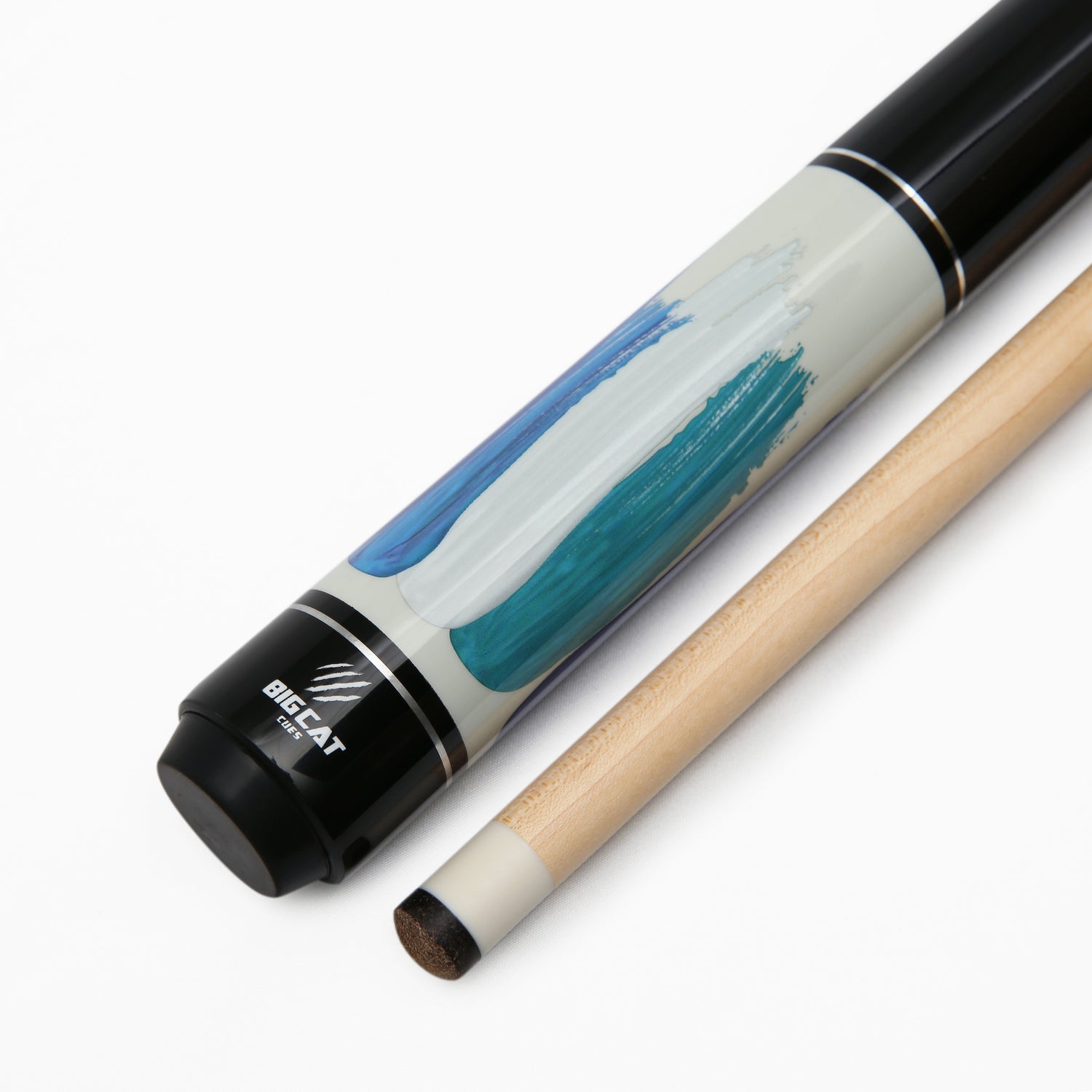
How to Get Better at Pool: A Step-by-Step Guide
Key Takeaways
-
Understanding pool rules, game plays, and pool terminology are the fundamentals to mastering pool, especially as a beginner. Dive in details with simple explanations below!
-
A proper stance and grip are essential for accuracy in pool. Align your shooting eye over the cue stick, maintain a stable stance, and hold the cue with a light but controlled grip. Learn how to get better at pool, starting with setting your stance and grip in this article!
-
Visualize the path from the pocket to the cue ball and focus on the contact point on the object ball. The trick from Big Cat’s expert is to master basic shots like stop, follow, and draw shots to control the cue ball’s movement. Explore tips to improve your aim and cue ball control below!

How to Get Better at Pool
Understand the Basics of Pool
How to get better at pool begins with understanding the rules of pool game and other types of pool games like 8-ball, 9-ball, or cutthroat pool. Here are simple explanations for those:
Pool Rules
Pool is about using the white ball (called the cue ball) to knock other colored balls into the pockets around the table. Which colored balls you're trying to hit depends on the type of pool game you're playing.
When it comes to taking turns, the rules are simple.
-
If you successfully pocket one of your balls, you get another shot.
-
Keep shooting until you miss, meaning no ball goes in a hole.
-
Then it's your opponent's turn, and they follow the same rule.
-
Once you hit the white ball into a hole, your turn ends immediately.
-
Your opponent gets to place the white ball anywhere on the table, but they must aim at balls on the opposite side.
Game Play
There are different pool games. The most common ones include:
1. Eight-Ball Pool
8 ball pool is the most common type of pool game you'll find.
When the game starts, the first shot determines which player gets solid or striped balls. If the first player pockets a solid ball, they'll play solids for the rest of the game while their opponent plays stripes, or vice versa. If they pocket both types on their first shot, they can choose which type they want. The black eight ball is special as it doesn't belong to either player.
The goal is to pocket all your balls first, then sink the ball numbered 8 to win.
But here's the catch: when you're ready to hit the eight ball, you must tell everyone which pocket you're aiming for. If you get the eight ball in the wrong pocket, or if you sink it before all your other balls are gone, you lose.

8-ball pool is the common pool gameplay. Source: Blatt Billiards
2. Nine Ball Pool
This 9-ball pool game works differently.
Instead of splitting the balls among players, everyone works on arranging them in numerical order, starting with ball number one. Players take turns trying to hit the lowest-numbered ball on the table into a pocket.
For example, you must hit the one ball first, then the two ball, and so on until the 9th ball. The player who pockets the most balls wins the game.

9-ball pool is also a popular type of pool game. Source: Blatt Billiards
3. Cutthroat Pool
Cutthroat pool occurs when you have a group of three or five players.
The balls are divided equally among everyone - with three players, each person gets five balls. While with five players, each gets three balls.
The twist is that players try to pocket their assigned balls while keeping other players' balls on the table. You can end the game when someone gets all their balls in, or play until only one person still has balls left on the table.

Cutthroat is best played in a group of 3 or 5 players
Key Terminology
Here are some pool terms you need to familiarize yourself with in order to play the pool game:
-
Cue: The stick you use to hit the balls on the pool table. Think of it as your main tool for playing the game.
-
Cue ball: The solid white ball that's different from all others. This is the only ball you're allowed to hit directly with your cue.
-
Numbered balls: The collection of balls on the table, each marked with its own number. They come in two styles: solid-colored ones and white ones with colored stripes.
-
Rack: A triangle-shaped frame used at the start of the game to arrange all the numbered balls in a neat triangle formation.
-
Chalk: The blue substance you apply to the tip of your cue. It helps create better friction between the cue tip and the cue ball, preventing the cue from slipping when you make your shot.
-
Pockets: The holes are located at each corner and middle of the table's long sides - six pockets in total. These are your targets where you'll try to knock the balls into during play.
See more: Pool Scratch Rules: 4 Ways To Avoid Scratch In Pool Like A Pro
How to Get Better at Pool
Now that you’ve known the general rules of pool games as well as different pool gameplays, it’s time to master the game, following these tricks on how to get good at pool:
Know Your Stance and Grip
How to practice pool starts with a proper stance and grip, which are the two fundamental elements that directly impact your shooting accuracy.
For the ideal stance, you’ll need:
-
Position yourself by lining up your front foot toward your target shot, keeping your back foot at a 45-degree angle for stability.
-
Bend at your waist, not your knees, and lower your head until your chin hovers just above the cue stick, ensuring your shooting eye aligns directly over it.
This position gives you the best view of your shot while maintaining balance.

Knowing your stance and grip is the fundamental step in mastering your pool game. Source: World of Pool & Billiards
When it comes to grip, players need to be firm enough to keep control but gentle enough to maintain sensitivity. What does that mean? Follow:
-
Use your back three fingers and thumb as your primary grip points. Your index finger and thumb should form a relaxed "V" shape to guide the cue. Don’t grip too tight, as this can reduce accuracy and control.
-
Maintain a grip pressure of about 4 out of 10, just enough to keep the cue stable while allowing smooth movement through your bridge hand.
Develop a Consistent Stroke
Wondering what is the key factor that decides how to get better at pool, a stroke!
A reliable stroke is the foundation of playing pool well. Your stroke should be smoothly controlled, yet follow the same path every time.
To build this consistency,
-
Before every shot, start with your pre-shot routine to get you into your pool stance and align your body with the shot line.
-
Set up a straight shot with the cue ball about 12 inches from your target ball.
-
Place guide balls on either side, creating a channel. Your goal is to pocket the target ball while drawing the cue ball back without touching the guide balls.
-
Start close and gradually increase the distance as you improve. The key is maintaining the same stroke mechanics regardless of the distance or power needed.
-
Pay special attention to your follow-through - it should be straight and level, about 4-6 inches past where you strike the cue ball.
Remember, power comes from a smooth acceleration through your stroke. If you find your accuracy declining during the process of how to practice pool, slow down and return to focusing on the fundamentals of your stroke.
Improve Your Aim and Accuracy
The secret to consistent accuracy in pool lies in the ability of a player to precisely visualize and measure the correct path of their balls toward the pocket before taking their shot.
This requires consistent practice to master, yet, you can start on how to get good at pool following these tricks:
-
Identify the center of your target pocket, as this is your ultimate destination.
-
From there, imagine a straight line running from the pocket's center through the middle of the object ball you want to sink. This imaginary line is crucial for proper aim.
-
Extend it all the way to where it meets your cue ball, showing you exactly where your pool balls need to make contact.
-
Keep visualizing your line before each attempt. As you improve, change to more challenging angles.
One common mistake during this step that most players are caught in is to focus on the cue tip during your shot, which gets your shot in an improper direction.
When you're set up for the shot, trust your alignment and keep your eyes on the target ball. Your eyes should track this line smoothly from pocket to object ball to cue ball, then strictly focus on your contact point on the object ball.
Learn to Control the Cue Ball
Want to know how to get better at pool as an advanced player?
Controlling the cue ball is what separates great players from good ones, and it all starts with understanding different types of spin.
Let's break down the essential shots and spins that give you command over the cue ball:
-
The stop shot is your foundation. Hit the cue ball one tip below the center, and it will stop dead after striking the object ball. This shot is how beginners familiarize themselves with the routine first.
-
For follow shots, strike slightly above center and follow through smoothly. The cue ball will continue forward after contact.
-
Conversely, draw shots (hitting below center) make the cue ball come back toward you after contact.

Advanced players always know how to control their cue ball
One other important practice that can open up a whole new dimension of control is side spin. The left spin (hitting at 9 o'clock) and right spin (3 o'clock) result in the cue ball curve after contact, giving you more options for position play.
The real magic happens when you combine these spins. For example, use top-right spin to widen angles and create a better position for your next shot.
To practice effectively, start with basic stop shots until you can consistently execute them. Then, progressively add follow-up and draw shots to your practice routine. Once comfortable, experiment with side spin combinations.
See more: How To Play Bumper Pool: 4 Rules And 5 Tips To Get You Started
Learn from Your Mistakes
Strategic thinking in pool is like playing chess, as you need to think several moves ahead to win. Instead of just focusing on making your current shot, you should plan your path around the table and position the cue ball for your next opportunities.
An ideal process on how to get good at pool always requires players to customize their own pre-shot routine that includes conducting the entire table.
Before taking any shot, ask yourself three key questions:
-
Which ball should I shoot next?
-
Where does the cue ball need to go for my next shot?
-
What obstacles might get in my way?
This mental checklist helps you avoid getting trapped in difficult positions and keeps your mindset straightforward.
To actually gain practical experiences and lessons, set up specific scenarios.
For example, first, arrange three balls that must be pocketed in a specific order, you should focus not just on making each shot but on leaving the cue ball in an ideal position for the next one. Lastly, maintaining a perfect position leaves you with an easier next shot and multiple backup options if things don't go exactly as planned.
Another trick is to try playing "ghost pool.” This means to rack all fifteen balls and challenge yourself to run the table without an opponent. This forces players to define their playing position and shot selection without the pressure of competition.
“Practice Makes Perfect”
How to get better at pool?
Practice, practice, practice, until it becomes a routine.
Here is a basic practice session you can follow:
-
Begin with straight shots from various distances for about 15 minutes to build muscle memory needed for more complex shots.
-
Move on to specific skills you want to improve, whether it's draw shots, position play, or banking.
-
Keep a simple practice log to track your progress and identify patterns in your game.
When you miss a shot, don't just reset and try again immediately. Instead, reflect on your performance: Was your stance off? Did you rush the shot? Did you misjudge the angle?
One tip from professional players is to record your practice sessions, as watching yourself can reveal technical flaws you might not feel while playing. If possible, find a more experienced player to watch your practice routine and provide feedback.

Practice pool games consistently to achieve desired results
Remember, effective practice isn't about quantity but quality. It's better to practice 30 minutes with full focus than two hours of casual shooting. Set specific goals for each practice session, like "I want to make 10 stop shots in a row" or "I want to practice drawing the cue ball back consistently."
See more: 9 Best Budget Pool Cue Choices for Beginners Under $200
Frequently Asked Questions
1. How long does it take to get better at the pool?
Getting better at pool varies by individual, but with consistent practice of 2-3 hours per week, you can see noticeable improvement in basic skills within 2-3 months. More advanced techniques and strategic play typically take 6-12 months to develop. Regular practice and proper guidance are key to steady improvement.
2. What’s the best way to practice pool at home?
If you have a home pool table, focus on daily fundamentals: practice straight shots for accuracy, cue ball control drills for positioning, and stop/draw shots for spin mastery. If you don't have a table, use a practice cue to perfect your stroke mechanics, or try phone apps that simulate pool physics and strategy.
3. How can I improve my cue ball control quickly?
Start with stop shots (hitting one tip below the center) until you are consistent. Then, practice follow shots (above the center) and draw shots (below the center). Focus on hitting the center of the cue ball cleanly.
4. Should I focus more on aiming or cue ball control?
Start with aiming fundamentals; they are the foundation of every shot. Once you can consistently pocket bath, focus on cue ball control. Think of it like learning to dive: first, master steering (aiming), then learn speed control (cue ball). Both skills work together to improve overall play.


